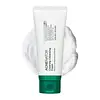What's inside
What's inside
 Key Ingredients
Key Ingredients

 Benefits
Benefits

 Concerns
Concerns

No concerns
 Ingredients Side-by-side
Ingredients Side-by-side

Water
Skin ConditioningAloe Barbadensis Leaf Extract
EmollientDecyl Glucoside
CleansingCocamidopropyl Hydroxysultaine
CleansingSodium Lauryl Sulfoacetate
CleansingDisodium Laureth Sulfosuccinate
CleansingGlycerin
HumectantSodium Methyl Cocoyl Taurate
CleansingCoco-Glucoside
CleansingGlyceryl Oleate
EmollientSodium Cocoyl Isethionate
CleansingCitrus Nobilis Peel Oil
MaskingPropanediol
SolventTremella Fuciformis Sporocarp Extract
AntioxidantBetaine
HumectantSodium Ascorbyl Phosphate
AntioxidantGluconolactone
Skin ConditioningSclerotium Gum
Emulsion StabilisingXanthan Gum
EmulsifyingHydroxyacetophenone
AntioxidantTetrasodium Glutamate Diacetate
Niacinamide
SmoothingPanthenol
Skin ConditioningCitrus Aurantifolia Oil
CleansingPrunus Serrulata Flower Extract
Skin ConditioningLactic Acid
BufferingAllantoin
Skin ConditioningCitrus Reticulata Peel Oil
MaskingGlycyrrhiza Glabra Root Extract
BleachingHippophae Rhamnoides Seed Oil
Skin ProtectingArnica Montana Flower Extract
MaskingCamellia Sinensis Leaf Extract
AntimicrobialMagnesium PCA
HumectantCopper PCA
HumectantZinc PCA
HumectantGlucosyl Hesperidin
HumectantHelianthus Annuus Seed Oil
EmollientCapsaicin
MaskingTocopherol
AntioxidantCitric Acid
BufferingPhenethyl Alcohol
MaskingPentylene Glycol
Skin ConditioningWater, Aloe Barbadensis Leaf Extract, Decyl Glucoside, Cocamidopropyl Hydroxysultaine, Sodium Lauryl Sulfoacetate, Disodium Laureth Sulfosuccinate, Glycerin, Sodium Methyl Cocoyl Taurate, Coco-Glucoside, Glyceryl Oleate, Sodium Cocoyl Isethionate, Citrus Nobilis Peel Oil, Propanediol, Tremella Fuciformis Sporocarp Extract, Betaine, Sodium Ascorbyl Phosphate, Gluconolactone, Sclerotium Gum, Xanthan Gum, Hydroxyacetophenone, Tetrasodium Glutamate Diacetate, Niacinamide, Panthenol, Citrus Aurantifolia Oil, Prunus Serrulata Flower Extract, Lactic Acid, Allantoin, Citrus Reticulata Peel Oil, Glycyrrhiza Glabra Root Extract, Hippophae Rhamnoides Seed Oil, Arnica Montana Flower Extract, Camellia Sinensis Leaf Extract, Magnesium PCA, Copper PCA, Zinc PCA, Glucosyl Hesperidin, Helianthus Annuus Seed Oil, Capsaicin, Tocopherol, Citric Acid, Phenethyl Alcohol, Pentylene Glycol
Glycerin
HumectantLeptospermum Scoparium Leaf Extract
Skin ConditioningWater
Skin ConditioningSodium Cocoyl Glycinate
CleansingSodium Lauroyl Glutamate
1,2-Hexanediol
Skin ConditioningLaminaria Japonica Extract
Skin ProtectingEclipta Prostrata Leaf Extract
Skin ConditioningHamamelis Virginiana Extract
AntiseborrhoeicMelaleuca Alternifolia Leaf Oil
AntioxidantHydrogenated Lecithin
EmulsifyingCoco-Betaine
CleansingSalicylic Acid
MaskingAcrylates/C10-30 Alkyl Acrylate Crosspolymer
Emulsion StabilisingCitric Acid
BufferingBeta-Glucan
Skin ConditioningFructooligosaccharides
HumectantGluconolactone
Skin ConditioningHydrolyzed Hyaluronic Acid
Humectant4-Terpineol
MaskingZinc PCA
HumectantCapryloyl Salicylic Acid
ExfoliatingHydroxyacetophenone
AntioxidantEthylhexylglycerin
Skin ConditioningGlycerin, Leptospermum Scoparium Leaf Extract, Water, Sodium Cocoyl Glycinate, Sodium Lauroyl Glutamate, 1,2-Hexanediol, Laminaria Japonica Extract, Eclipta Prostrata Leaf Extract, Hamamelis Virginiana Extract, Melaleuca Alternifolia Leaf Oil, Hydrogenated Lecithin, Coco-Betaine, Salicylic Acid, Acrylates/C10-30 Alkyl Acrylate Crosspolymer, Citric Acid, Beta-Glucan, Fructooligosaccharides, Gluconolactone, Hydrolyzed Hyaluronic Acid, 4-Terpineol, Zinc PCA, Capryloyl Salicylic Acid, Hydroxyacetophenone, Ethylhexylglycerin
Ingredients Explained
These ingredients are found in both products.
Ingredients higher up in an ingredient list are typically present in a larger amount.
Citric Acid is an alpha hydroxy acid (AHA) naturally found in citrus fruits like oranges, lemons, and limes.
Like other AHAs, citric acid can exfoliate skin by breaking down the bonds that hold dead skin cells together. This helps reveal smoother and brighter skin underneath.
However, this exfoliating effect only happens at high concentrations (20%) which can be hard to find in cosmetic products.
Due to this, citric acid is usually included in small amounts as a pH adjuster. This helps keep products slightly more acidic and compatible with skin's natural pH.
In skincare formulas, citric acid can:
While it can provide some skin benefits, research shows lactic acid and glycolic acid are generally more effective and less irritating exfoliants.
Most citric acid used in skincare today is made by fermenting sugars (usually from molasses). This synthetic version is identical to the natural citrus form but easier to stabilize and use in formulations.
Read more about some other popular AHA's here:
Learn more about Citric AcidGluconolactone is a PHA. PHAs are a great gentle alternative to traditional AHAs.
When applied, Gluconolactone has the same affect on skin as AHAs such as lactic acid. It helps dissolve the dead skin cells in the top layer of your skin. This improves texture and brightens the skin.
PHAs are more gentle than AHAs due to their larger structure. They do not penetrate as deeply as AHAs and take a longer time to dissolve dead cells. Studies show PHAs do not cause as much irritation.
Gluconolactone has some interesting properties:
In a 2004 study, Gluconolactone was found to prevent UV damage in mouse skin cells and has not been found to increase sun sensitivity. However, we still recommend wearing SPF daily.
This ingredient is is an created by reacting gluconic acid with an alcohol.
Learn more about GluconolactoneGlycerin is already naturally found in your skin. It helps moisturize and protect your skin.
A study from 2016 found glycerin to be more effective as a humectant than AHAs and hyaluronic acid.
As a humectant, it helps the skin stay hydrated by pulling moisture to your skin. The low molecular weight of glycerin allows it to pull moisture into the deeper layers of your skin.
Hydrated skin improves your skin barrier; Your skin barrier helps protect against irritants and bacteria.
Glycerin has also been found to have antimicrobial and antiviral properties. Due to these properties, glycerin is often used in wound and burn treatments.
In cosmetics, glycerin is usually derived from plants such as soybean or palm. However, it can also be sourced from animals, such as tallow or animal fat.
This ingredient is organic, colorless, odorless, and non-toxic.
Glycerin is the name for this ingredient in American English. British English uses Glycerol/Glycerine.
Learn more about GlycerinHydroxyacetophenone is antioxidant with skin conditioning and soothing properties. It also boosts the efficiency of preservatives.
This ingredient is not irritating or sensitizing.
Water. It's the most common cosmetic ingredient of all. You'll usually see it at the top of ingredient lists, meaning that it makes up the largest part of the product.
So why is it so popular? Water most often acts as a solvent - this means that it helps dissolve other ingredients into the formulation.
You'll also recognize water as that liquid we all need to stay alive. If you see this, drink a glass of water. Stay hydrated!
Learn more about WaterZinc PCA (or "zinc salt") differs slightly from zinc itself. PCA stands for pyrrolidone carboxylic acid. However, Zinc PCA comes from zinc.
It can help reduce redness, regulate sebum, and promote the general healing process of the skin.
Zinc PCA tends to be especially useful for those with oily, acne-prone skin. It's certainly an ingredient worth trying out!
Learn more about Zinc PCA